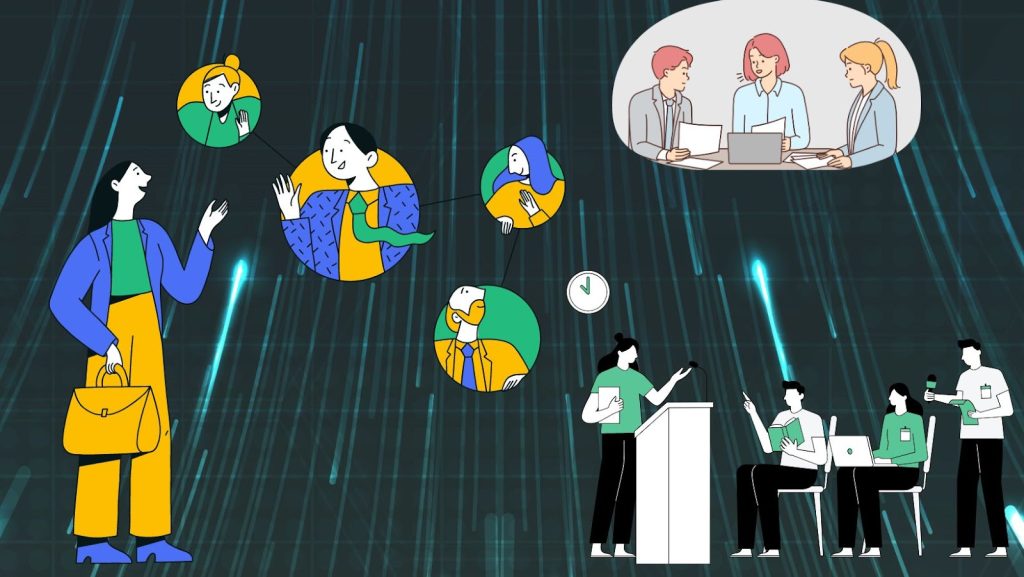Speed networking events have become popular as a way for professionals to make valuable connections in a short amount of time. These events offer a structured format that allows participants to meet a large number of individuals quickly and efficiently. However, hosting a successful speed networking event requires careful planning, right questions and attention to detail. In this article, we will learn a step-by-step guide on how to organize speed networking for events, from pre-event preparation to post-event follow-up.
Step 1. Define Your Objectives and Target Audience:
Before organizing a speed networking event, it’s essential to clearly define your objectives and identify your target audience. Consider what you want participants to gain from the event and who would benefit the most from attending. Understanding your objectives and target audience will help shape the structure, format, and overall experience of the event.
Step 2. Plan Logistics and Set a Date:
Once you have defined your objectives and target audience, begin planning the logistics of the event. Determine the date, time, and duration of the event, considering factors such as participants’ availability and the nature of the industry or profession involved. Select a suitable venue that can accommodate the desired number of participants comfortably and provide the necessary amenities for a smooth networking experience.
Step 3. Promote the Event:

Effective promotion is crucial for attracting the right participants to your speed networking event. Utilize various channels to spread the word, such as social media platforms, professional networks, industry associations, and targeted email campaigns. Clearly communicate the benefits of attending the event, emphasizing the opportunity to meet like-minded professionals, expand networks, and forge valuable connections.
Step 4. Develop a Structured Format:
The success of a speed networking event relies on a well-structured format that maximizes participant engagement and facilitates efficient networking. Consider the following elements when designing the format:
a. Time Allocation: Determine the duration of each networking round, allowing participants enough time for introductions and conversations without feeling rushed. Typically, 3-5 minutes per interaction is ideal.
b. Rotational System: Establish a rotational system where participants switch partners after each networking round. This ensures that everyone has the opportunity to meet a variety of individuals.
c. Icebreaker Questions: Provide participants with a set of icebreaker questions or conversation starters to help initiate meaningful discussions. These prompts can break the ice and encourage participants to delve deeper into their professional backgrounds and aspirations.
Step 5. Prepare Networking Materials:
To facilitate smooth networking interactions, provide participants with the necessary materials. This includes name tags or badges with visible names and affiliations, as well as a brief description of each participant’s professional background. These materials help participants identify each other quickly and foster more meaningful conversations.
Step 6. Facilitate Networking Sessions:

During the event, it is crucial to establish a conducive environment that encourages networking and interaction. Consider the following strategies:
a. Clear Instructions: Begin the event with a brief introduction and provide clear instructions on the format, timing, and expectations. This will ensure that participants understand how the speed networking sessions will unfold.
b. Facilitator Guidance: Appoint facilitators or moderators to guide participants through the networking rounds, ensuring that they adhere to the allotted time and smoothly transition between partners.
c. Networking Stations: Set up designated networking stations or tables where participants can interact with each other. Arrange the stations in a way that allows for easy movement and minimizes distractions.
Step 7. Foster Post-Event Follow-Up:
A successful speed networking event goes beyond the actual event itself. Encourage participants to follow up with the connections they made to further develop relationships and explore potential collaborations. Provide participants with digital platforms or resources where they can access contact information, such as an event app.
Learn more about the post event engagement strategies to ensure engaged audience.
Step 8. Gather Feedback and Measure Success:
After the event, gather feedback from participants to assess the success of the speed networking event. Distribute surveys or collect testimonials to gain insights into attendees’ experiences and identify areas for improvement. To evaluate success, measure the performance metrics such as participant satisfaction, the number of connections made, and any business opportunities that arose as a result of the networking.
Why Should You Organize A Speed Networking Event

Hosting speed networking events offer a range of benefits for professionals looking to expand their networks and make valuable connections. Here are some key benefits of participating in speed networking events:
1. Efficient and Time-Saving:
Speed networking events provide a highly efficient way to meet and connect with a large number of professionals in a short period. Unlike traditional networking events, where participants may spend hours mingling and hoping to make connections, speed networking events offer structured and timed interactions. This allows participants to maximize their time and engage with a diverse group of individuals, ultimately saving valuable time and effort.
2. Broaden Professional Networks:
Speed networking events attract professionals from various industries, backgrounds, and career levels. This diversity provides an excellent opportunity to broaden professional networks and connect with individuals who may not have been accessible through other means. By engaging with a diverse group of professionals, participants can gain new perspectives, insights, and potential business opportunities that can enrich their professional journey.
3. Exposure to New Opportunities:
Speed networking events often attract professionals from different industries or sectors. This exposure to diverse individuals and industries can open doors to new opportunities that participants may not have been aware of previously. Through conversations and connections made during the event, participants can learn about potential job openings, collaborations, partnerships, or business ventures that align with their interests and goals.
4. Professional Development and Learning:
In addition to networking, speed networking for events often incorporate educational or informative elements. This can include guest speakers, panel discussions, or workshops on relevant professional topics. Participating in these events allows attendees to gain valuable knowledge, insights, and industry trends. It provides an opportunity for continuous learning, professional development, and staying up to date with the latest advancements in their respective fields.
5. Access to a Supportive Community:
Speed networking for events often foster a supportive and collaborative environment. Participants share a common goal of expanding their networks and forging meaningful connections. This sense of camaraderie can lead to the formation of a supportive community where professionals can exchange ideas, provide advice, and support each other’s professional growth.
Learn more: How event matchmaking app helps build network and connections.
Promotional Tips For a Speed Networking Event

Promoting a speed networking event effectively is essential to attract participants and ensure its success. Here are some promotional tips to help you spread the word about your event:
1. Define Your Target Audience:
Clearly identify the target audience for your speed networking event. Determine the industries, professions, or specific groups of professionals who would benefit most from attending. This will help you tailor your promotional efforts and reach the right audience.
2. Utilize Online Platforms:
Leverage various online platforms to promote your event. Create a dedicated event page on your website or use event management platforms to showcase event details and enable easy registration. Utilize social media platforms such as LinkedIn, Twitter, Facebook, and professional networking platforms to share event updates, engage with potential participants, and reach a wider audience.
3. Personalized Email Marketing:
Develop an email marketing campaign to reach out to your existing contacts and potential participants. Craft personalized and compelling emails that highlight the unique value proposition of your speed networking event. Segment your email list based on relevant criteria, such as industry or professional interests, and tailor your messaging accordingly.
4. Collaborate with Partners and Sponsors:
Collaborate with industry partners, associations, or sponsors who share a similar target audience. Seek their support in promoting the event by sharing it with their networks, featuring it in their newsletters or websites, or co-hosting the event. This collaboration can significantly expand your reach and lend credibility to your event.
5. Engage Influencers and Thought Leaders:
Identify influencers and thought leaders in your industry or professional community who have a strong online presence and a relevant following. Reach out to them and invite them to attend or speak at your speed networking event. Their endorsement and promotion can significantly boost awareness and attract participants.
6. Leverage Local Networks:
Tap into local networking groups, business chambers, or professional associations in your area. Attend relevant networking events or meetings and promote your speed networking event to the attendees. Connect with local influencers or community leaders who can help spread the word among their networks.
Learn more: Tradeshow Marketing Ideas & Strategies to Boost Business Leads
5 Common Problems Faced During Speed Networking Events and Their Solution
Speed networking events have gained popularity as effective platforms for professionals to connect and expand their networks. However, like any event, speed networking events can encounter certain challenges that may hinder participants’ experiences. Here are five common problems faced during speed networking events:
1.Insufficient Time for Meaningful Connections:
One of the primary challenges in speed networking events is the limited time allocated for each interaction. While the time constraint is intended to encourage efficiency, it can sometimes be too short for participants to establish meaningful connections or engage in in-depth conversations. This can leave participants feeling rushed and hinder the potential for building substantial professional relationships.
Solution: Consider extending the time per interaction or adjusting the structure to allow for longer conversations. While the goal is to maximize the number of connections, quality interactions should be prioritized over quantity.
2.Uneven Participant Engagement:
Another challenge is ensuring equal participation and engagement among all attendees. In some instances, participants may dominate the conversations, leaving little opportunity for others to contribute or make an impression. This can result in an imbalanced networking experience and dissatisfaction among participants who feel marginalized.

Solution: Assign facilitators or moderators who actively monitor and manage the networking sessions. They can encourage balanced participation, ensure everyone gets an equal chance to speak, and intervene if necessary to maintain a fair and inclusive environment.
3.Networking Fatigue:
Speed networking events can be mentally and physically exhausting, particularly for participants who are introverted or new to networking. The constant rotation, quick conversations, and pressure to make a positive impression can lead to networking fatigue, diminishing the quality of interactions as the event progresses.
Solution: Incorporate short breaks between networking rounds to allow participants to recharge. Offer a designated area where attendees can take a brief pause, grab refreshments, and collect their thoughts before engaging with new contacts.
4.Lack of Follow-Up Opportunities:
While speed networking events provide a platform for initial connections, the challenge lies in ensuring that participants have opportunities for follow-up and continued engagement after the event. Without a clear follow-up plan, the connections made during the event may fizzle out, limiting the long-term benefits for participants.
Solution: Provide participants with resources or digital platforms where they can access contact information and continue conversations beyond the event. Encourage attendees to exchange business cards or connect on professional networking platforms, and emphasize the importance of post-event follow-up to nurture relationships.
5.Limited Diversity and Variation:
In some cases, speed networking events may suffer from a lack of diversity and variation in participants’ professional backgrounds or industries. When attendees share similar backgrounds or work in closely related fields, the potential for fresh perspectives and new opportunities may be limited.
Solution: Implement strategies to attract a diverse range of professionals to the event. Expand promotional efforts to reach different industries and professional networks. Partner with organizations or associations representing various sectors to encourage broader participation. Ensuring a diverse participant pool enhances the chances of meaningful connections and fosters a more enriching networking experience.
Final Words
Hosting a successful speed networking event requires careful planning and attention to detail. By following the steps, you can create a memorable and productive networking experience for participants. With proper planning and execution, a well-organized speed networking event can provide professionals with invaluable connections, foster collaborations, and contribute to their professional growth.
FAQs
A speed networking event is a structured networking format where participants engage in a series of brief, timed conversations with other attendees. Similar to speed dating, participants rotate through different stations or tables, typically spending a few minutes at each station before moving on to the next. The goal is to facilitate a high volume of introductions and connections within a short period, allowing participants to expand their professional networks efficiently.
Planning a successful speed networking event involves several key steps, including defining clear objectives and target audience, selecting a suitable venue, establishing a clear agenda and timeline, promoting the event effectively, facilitating participant registration and preparation, designing the layout of the networking space, assigning experienced facilitators, and collecting post-event feedback for evaluation and improvement.
The success of a speed networking event can be measured through various metrics, including attendance rates, participant demographics, networking activity, participant satisfaction, and post-event feedback. By collecting and analyzing quantitative and qualitative data, event organizers can assess the event’s impact, identify areas for improvement, and refine future events to maximize their effectiveness and ROI.






